
A pair of trumpeter swans like these, along with a lone cygnet, nested in Indiana this year for the first time since modern bird watching records have been kept. Photo by iStock/Getty Images Plus
A pair of endangered trumpeter swans have successfully hatched an offspring in Indiana for the first time since modern bird watching records have been kept. The swan family is in northeastern Indiana’s Steuben County.
Before 2017, sightings of trumpeter swan families in Indiana were limited to winter, with the birds breeding in other states.
Trumpeter swans have been successfully reintroduced in Iowa, Michigan, Minnesota, Ohio and Wisconsin, and in Ontario, Canada. With breeding birds in nearby states, the natural range expansion back into Indiana was expected, according to Adam Phelps, waterfowl biologist with the DNR Division of Fish & Wildlife.
“It’s a great success story that we have habitat that trumpeter swans need to breed,” Phelps said. “With any luck, this pair will return next year to successfully hatch more cygnets (young swans).”
Trumpeter swans lay an average of four or five eggs per clutch. The existence of only one cygnet may indicate predators ate other eggs or other cygnets.
“It may also be that this female only successfully hatched one egg this year,” Phelps said.
 Trumpeter swans tend to return to their territories each year, and females tend to return to the site where they were hatched.
Trumpeter swans tend to return to their territories each year, and females tend to return to the site where they were hatched.
Trumpeter swans are one of two native swan species in North America. The other is the tundra swan.
The exotic and destructive mute swan is also present in Indiana. Trumpeter and tundra swans can be distinguished from mute swans because they have a mostly black or all-black bill, whereas adult mute swans have a bright orange bill. Also, mute swans have a large black knob at the base of the bill native swans lack.
However, juvenile swans are more difficult to identify because the orange coloration and black knob on the bill have not yet developed. By fall, juvenile mute swans have much lighter-colored bills than trumpeters of the same age.
Research of endangered species including trumpeter swans in Indiana is conducted by the DNR Division of Fish & Wildlife’s Wildlife Diversity Staff, which is funded primarily through donations to the Indiana Nongame Fund and federal grants.
To help endangered wildlife, donate at EndangeredWildlife.IN.gov. For every $5 donated, another $9 is matched in federal funds. Remember, for every $5 you give, wildlife ends up getting $14.
 JACK SPAULDING is a state outdoors writer and a consumer of RushShelby Energy living along the Flatrock River in Moscow. Readers with questions or comments can write to him in care of Electric Consumer or email jackspaulding@hughes.net.
JACK SPAULDING is a state outdoors writer and a consumer of RushShelby Energy living along the Flatrock River in Moscow. Readers with questions or comments can write to him in care of Electric Consumer or email jackspaulding@hughes.net.



